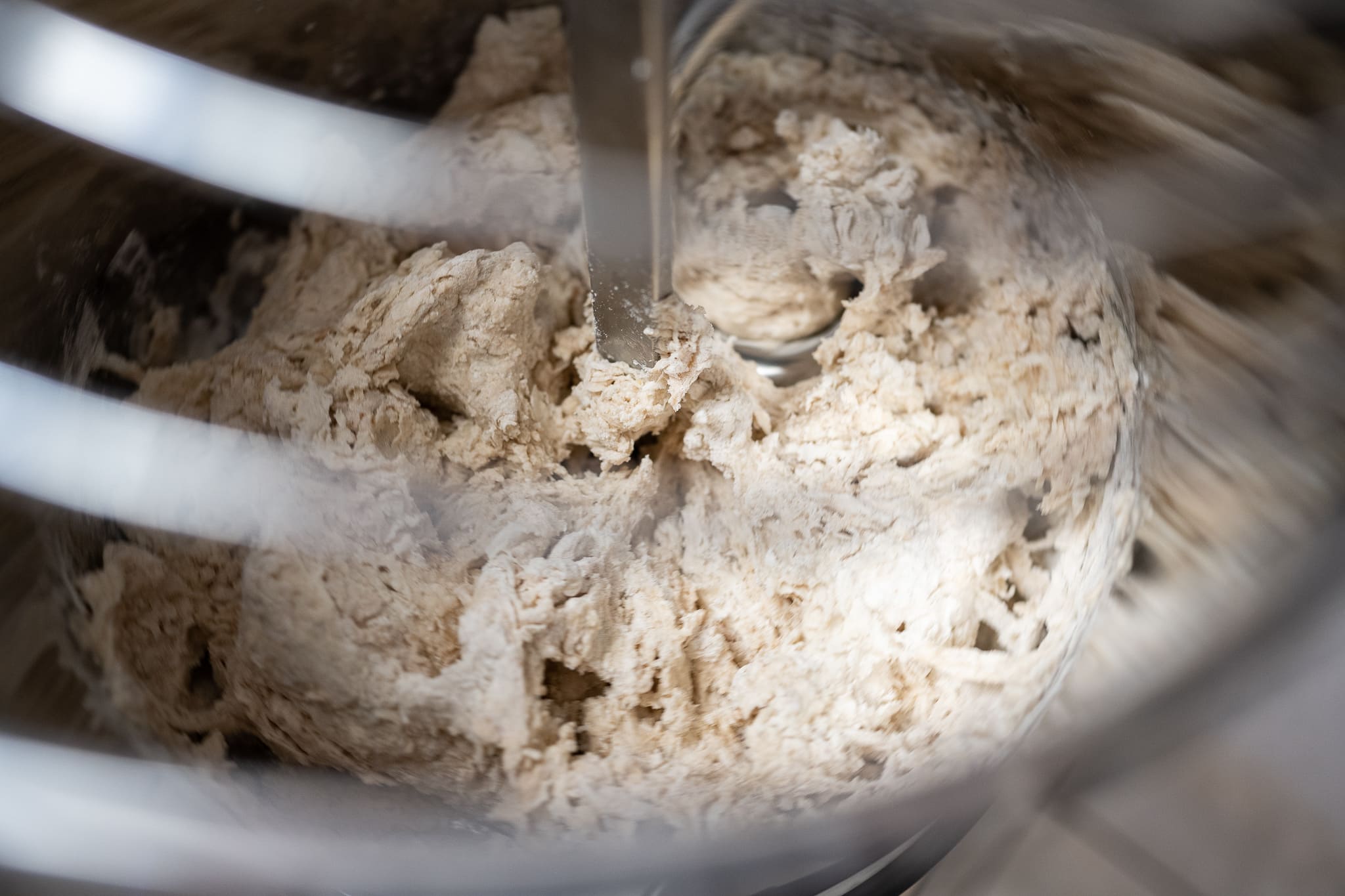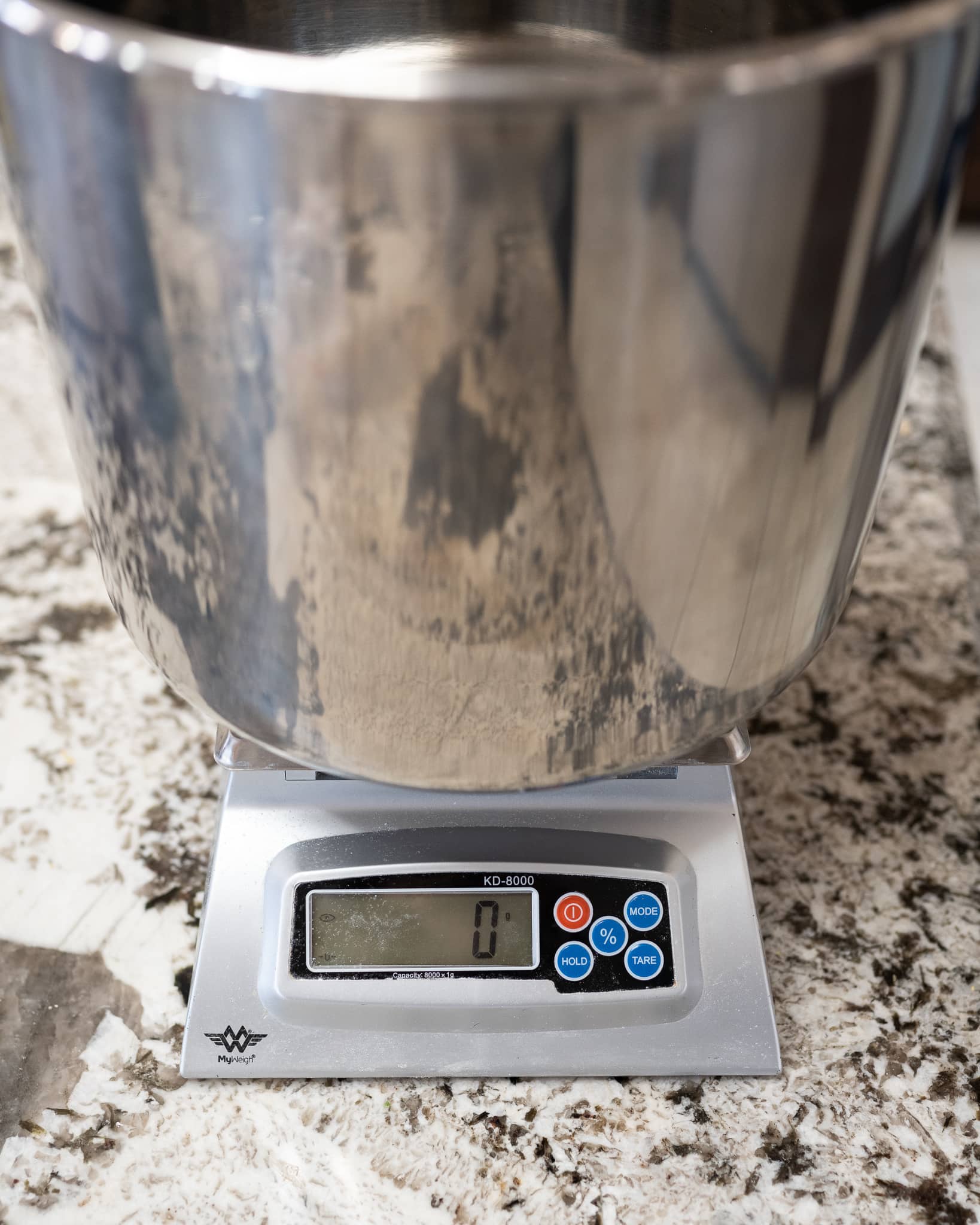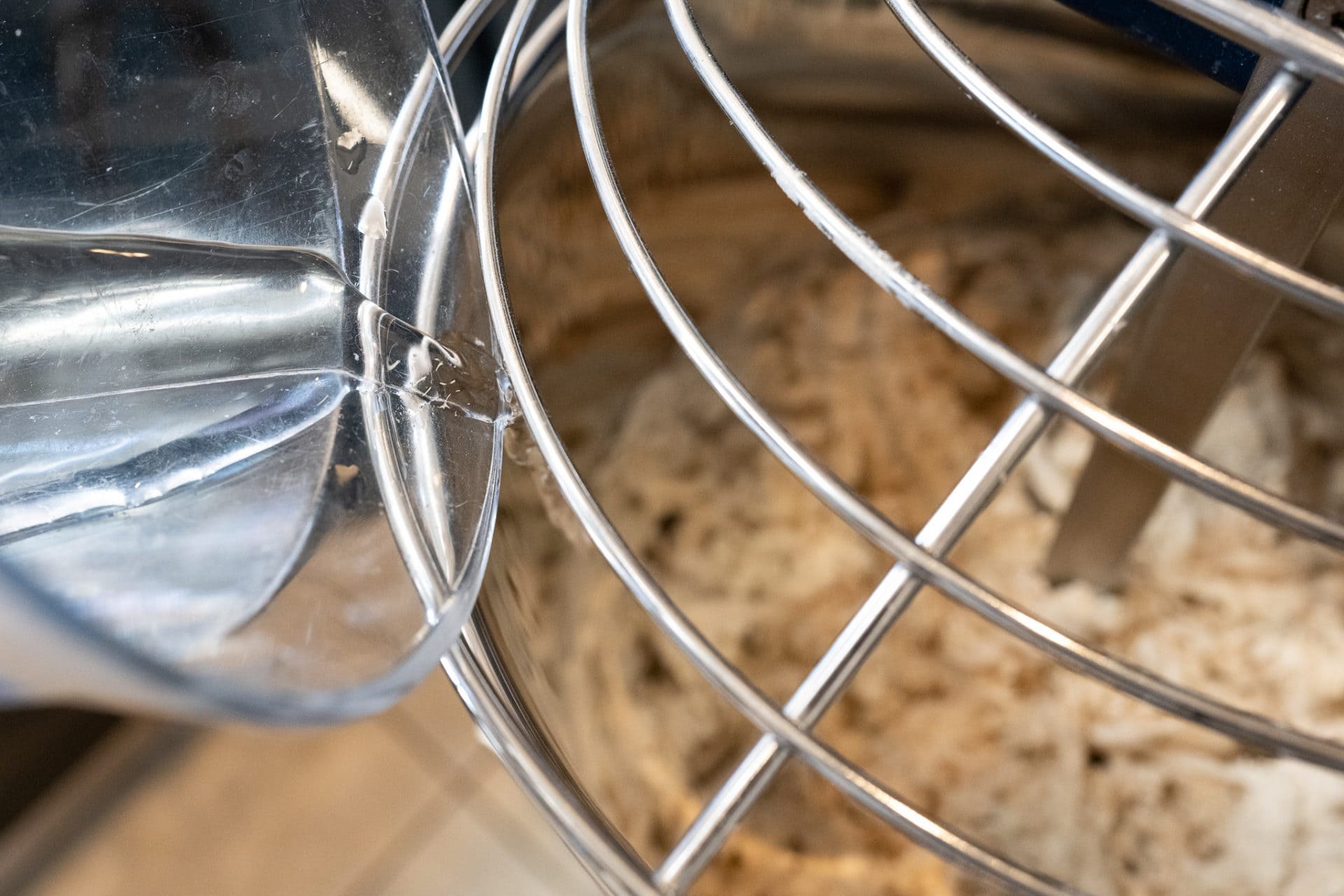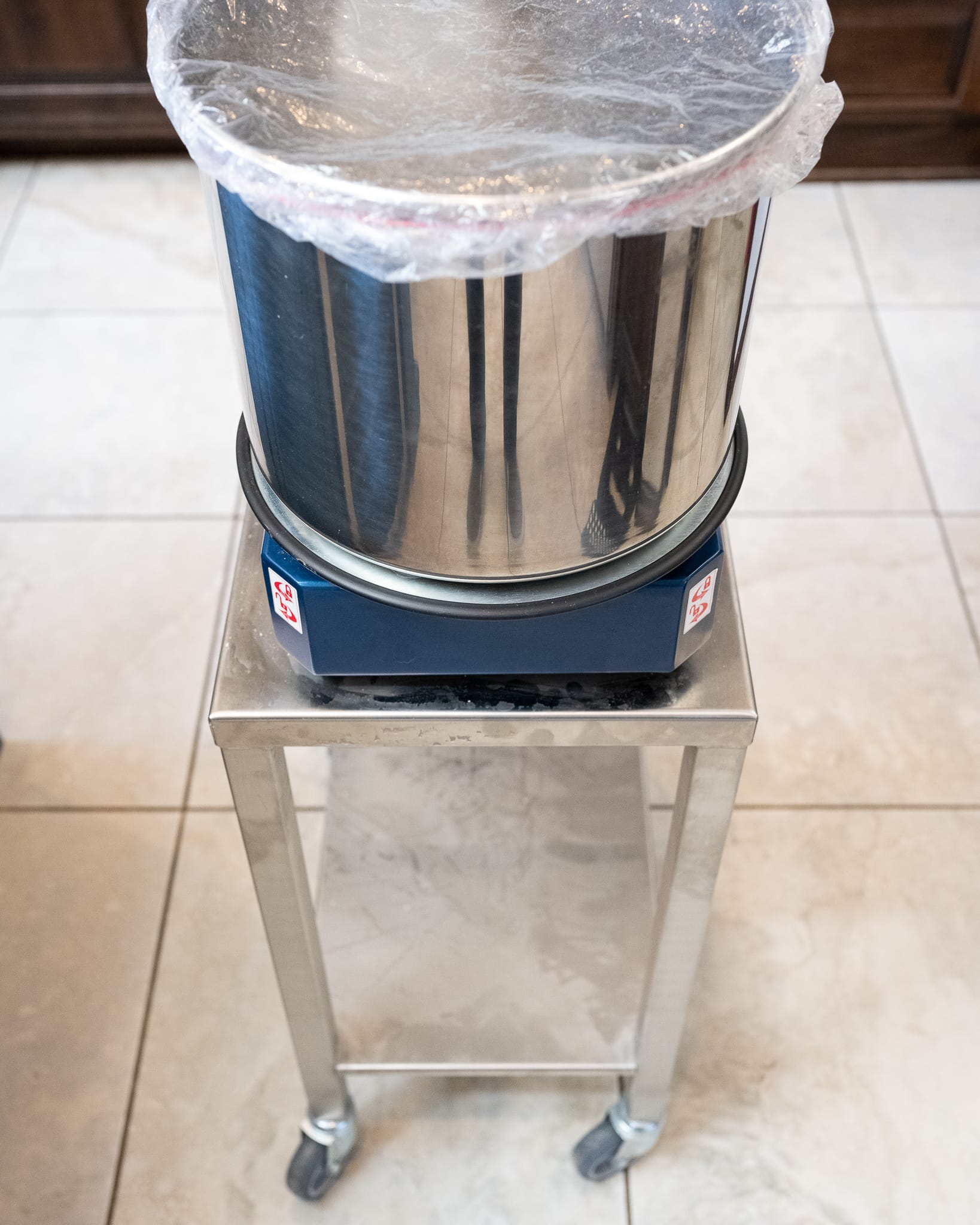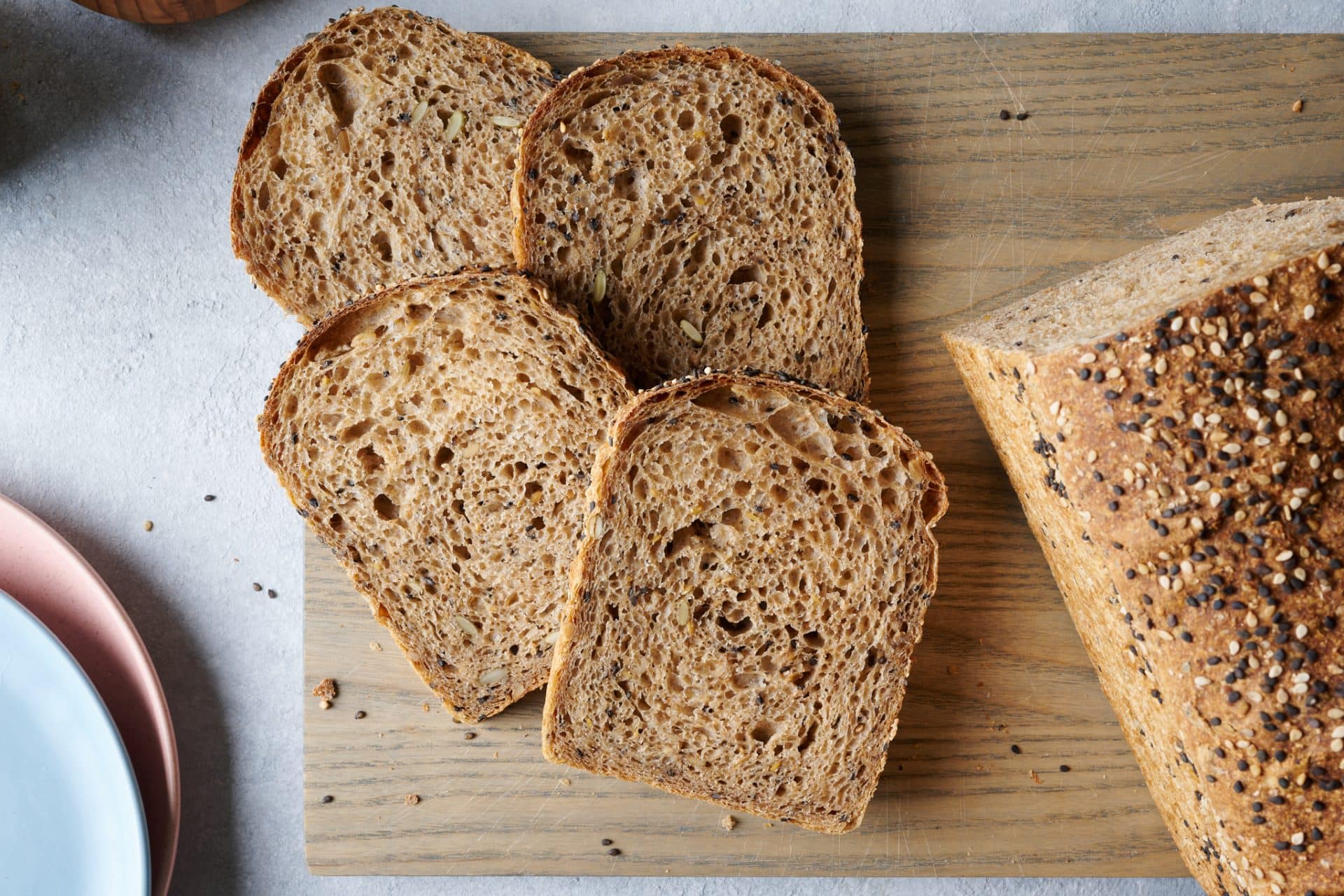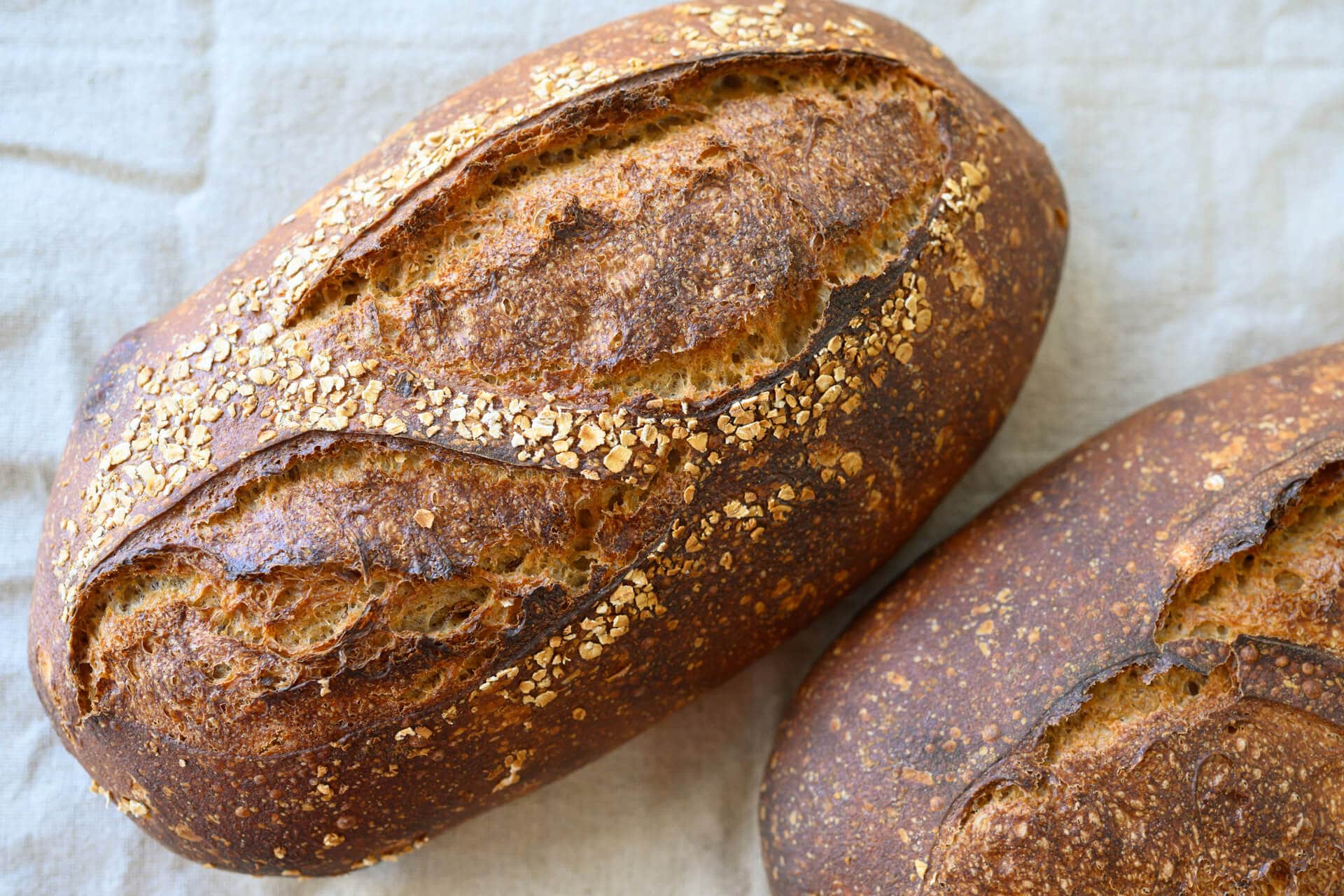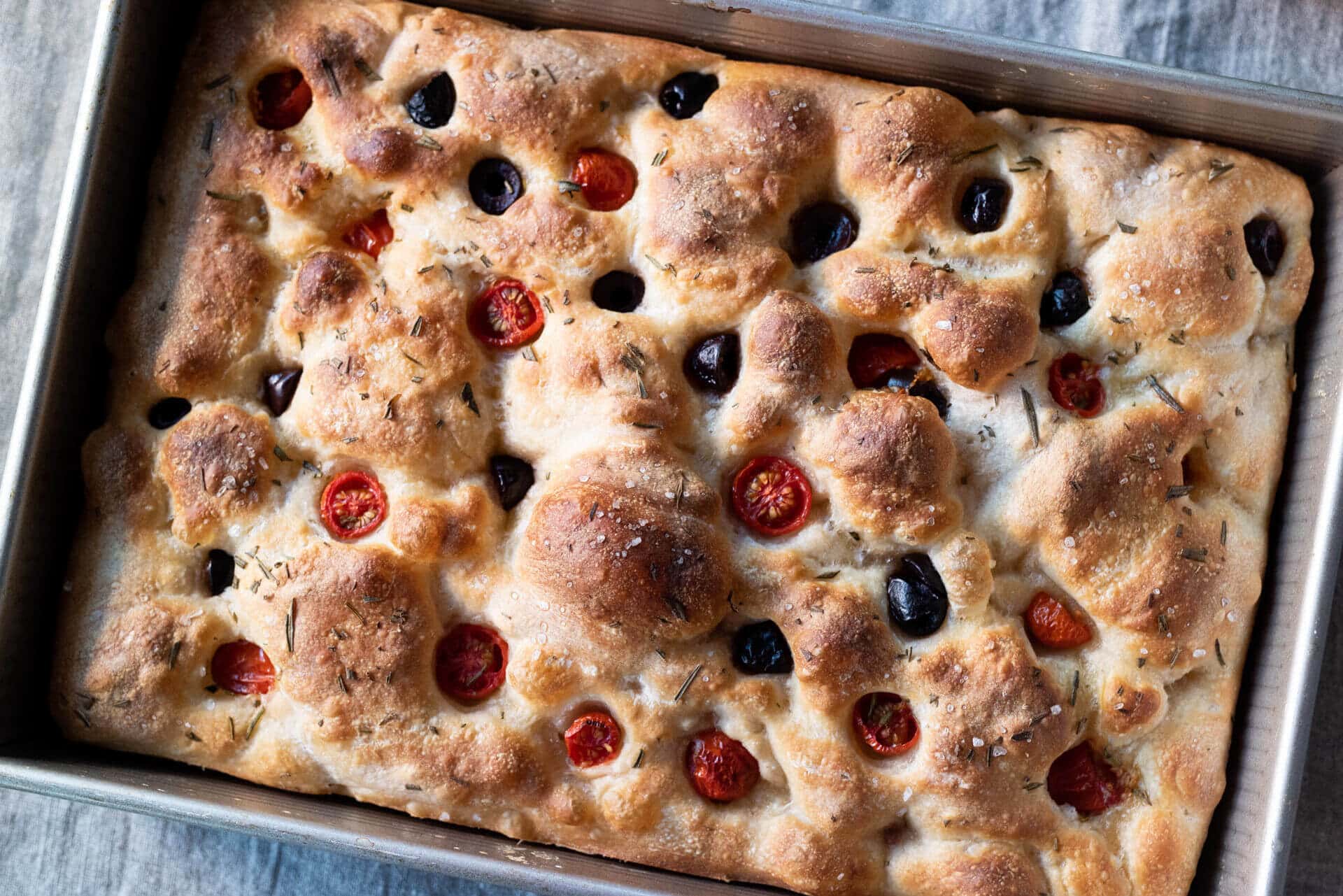This guide on how to use a Famag dough mixer is a look into how I use a larger spiral mixer when making larger batches of bread dough here in my home kitchen. The Famag IM-8S has an 8 kg dough capacity, a breaker bar, and a removable bowl. All great features for a spiral mixer, and in this post, I’ll go into how I use the mixer, its thoughtful design features, and a few things I wish it had.
While I mostly mix the recipes here at The Perfect Loaf by hand, I sometimes use my KitchenAid stand mixer for enriched doughs or a Famag spiral mixer to mix larger bread dough batches. I feel like the Famag IM-8S is one of the best small spiral mixers with a breaker bar (I’ll go into what this is later in this guide).
Full disclosure: Pleasant Hill Grain gave me this mixer when it was first released for my feedback without any expectations. But I’ve received so many emails about the mixer that I thought I’d put together this comprehensive guide for all.
Real Quick: Do I Recommend the Famag Dough Mixer?
In the end, I love the Famag IM-8S spiral dough mixer. It mixes bread dough incredibly well, is solidly built, and has a much-needed breaker bar to keep the dough from riding up the dough hook—all while having a small footprint perfect for the home kitchen. I highly recommend this as an option for those home bakers who want to mix larger bread dough quantities.
Read on for how to use a Famag dough mixer, including what I like and don’t like about its design. But first, let’s talk about what a spiral mixer will do for us.
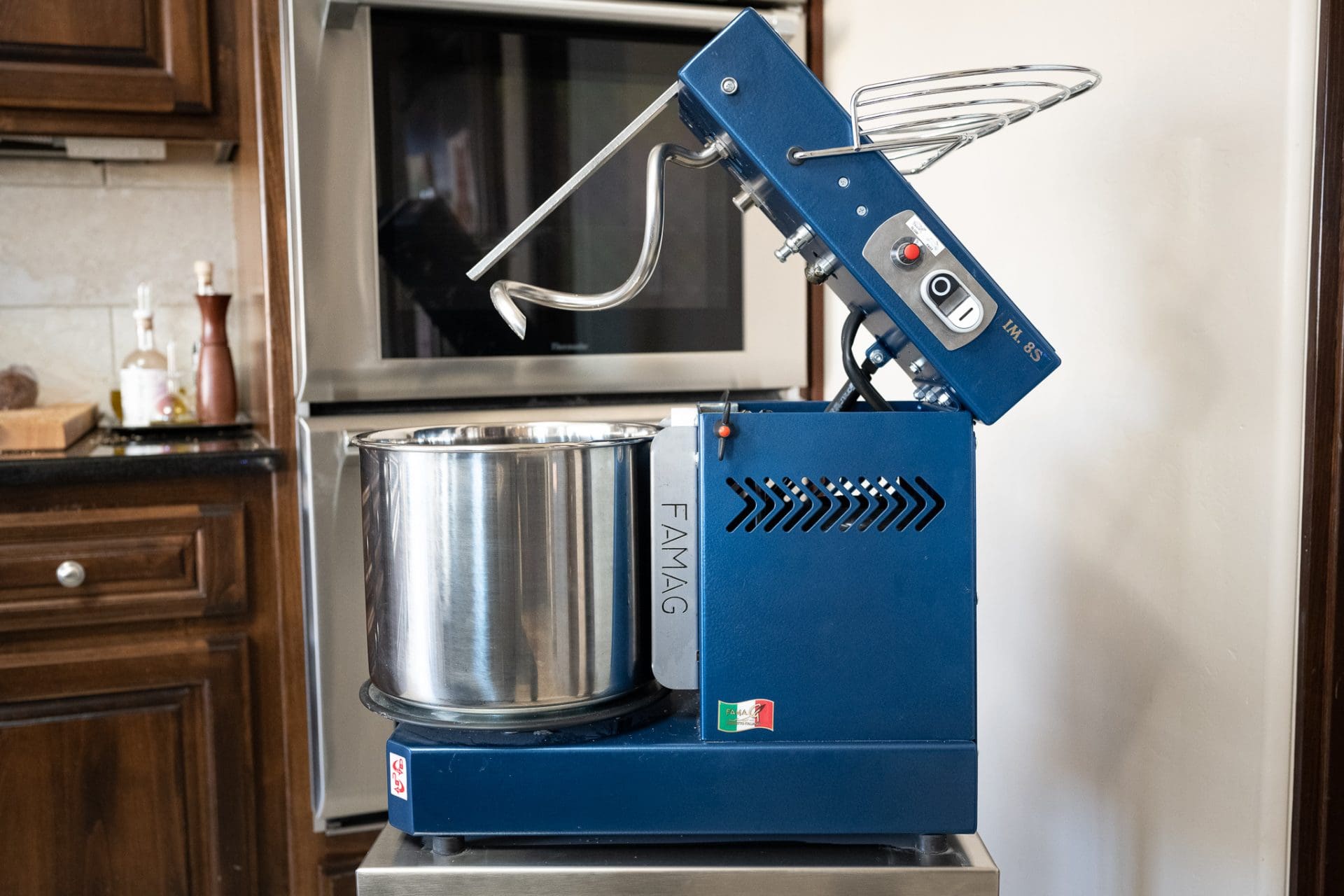
What is a Spiral Mixer?
A spiral mixer has a fixed dough hook that spins in place in the head of the mixer as the bowl rotates. Due to the design of the hook and its motion, it is incredibly efficient at quickly strengthening bread dough. Additionally, it incorporates a relatively large amount of air into the dough during mixing, which can help result in a more open loaf of bread.
By contrast, most home bakers are familiar with a KitchenAid-style planetary dough mixer. Planetary mixers are great for most doughs, especially for cookies, cakes, batter, and even pizza dough. A planetary mixer is designed so the mixing arm rotates around the mixing bowl while at the same time the hook (or paddle) attachment itself spins. Think about this action much like the Earth orbits the sun: the Earth spins on its axis while at the same time orbits around the sun (and hence the term “planetary”). Planetary mixers have a fixed mixing bowl and typically a single motor.
Recommended reading: The Importance of Dough Temperature in Baking.
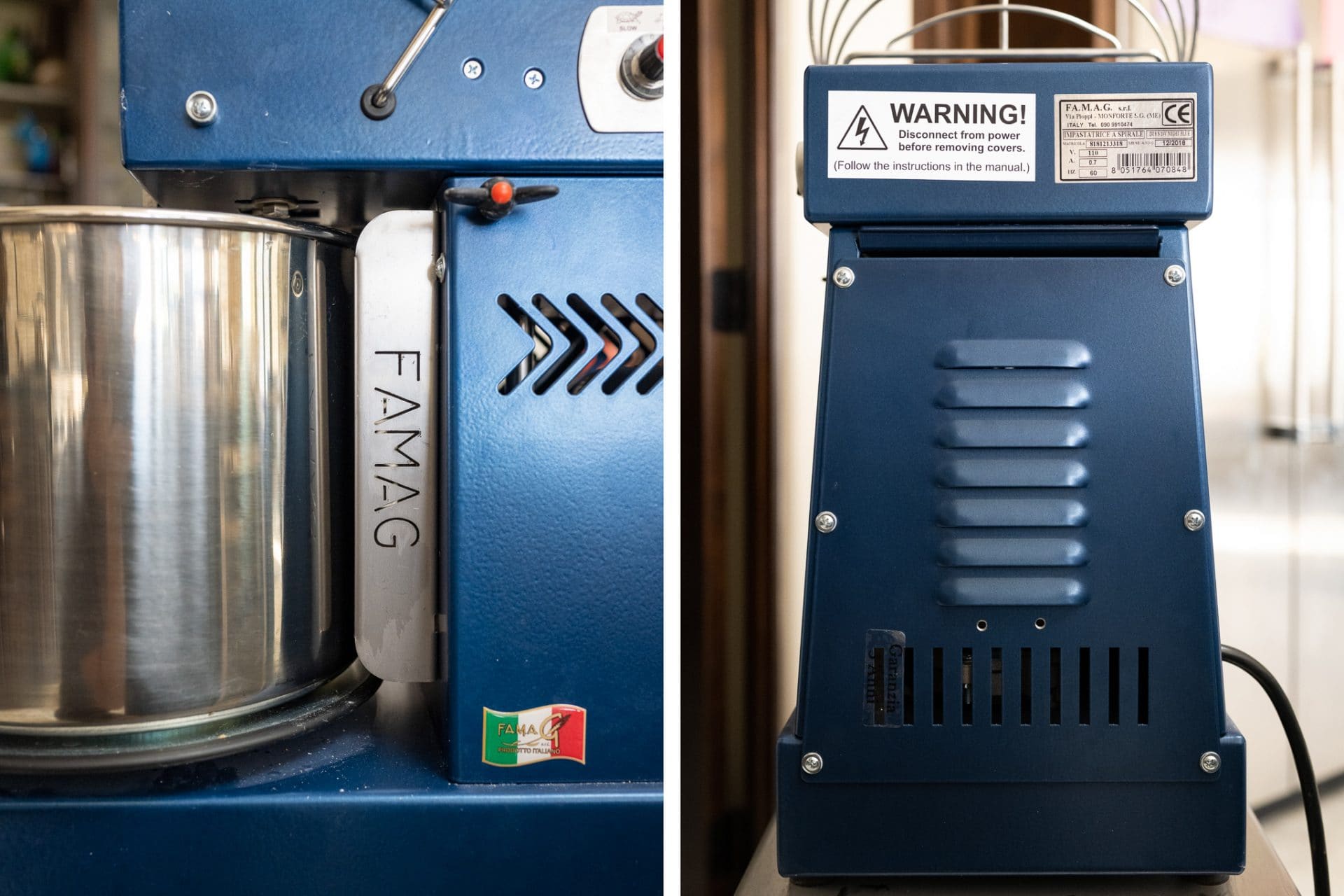
Famag Spiral Dough Mixer Specifications
Here are some high-level specifications for the Famag IM-8S spiral dough mixer1:
- Spiral mixer with tilt head and removable bowl2
- ~8kg dough capacity (based on my experience), bowl capacity of 11 liters
- Has a breaker bar (more on this below)
- 110V, made for home use
- 1/2 horsepower
- 77 lbs. total weight
- Analog speed control from speed 0 (80 RPM) to 10 (240 RPM)
Famag IM-8 versus IM-8S
There are two types of Famag mixers at this size: the IM-8 and the IM-8S. The IM-8 does not have a removable mixing bowl and the mixing head does not tilt up—they are both fixed. The IM-8S, the unit I have, has a removable bowl and the mixing head tilts up (to facilitate removing the bowl).
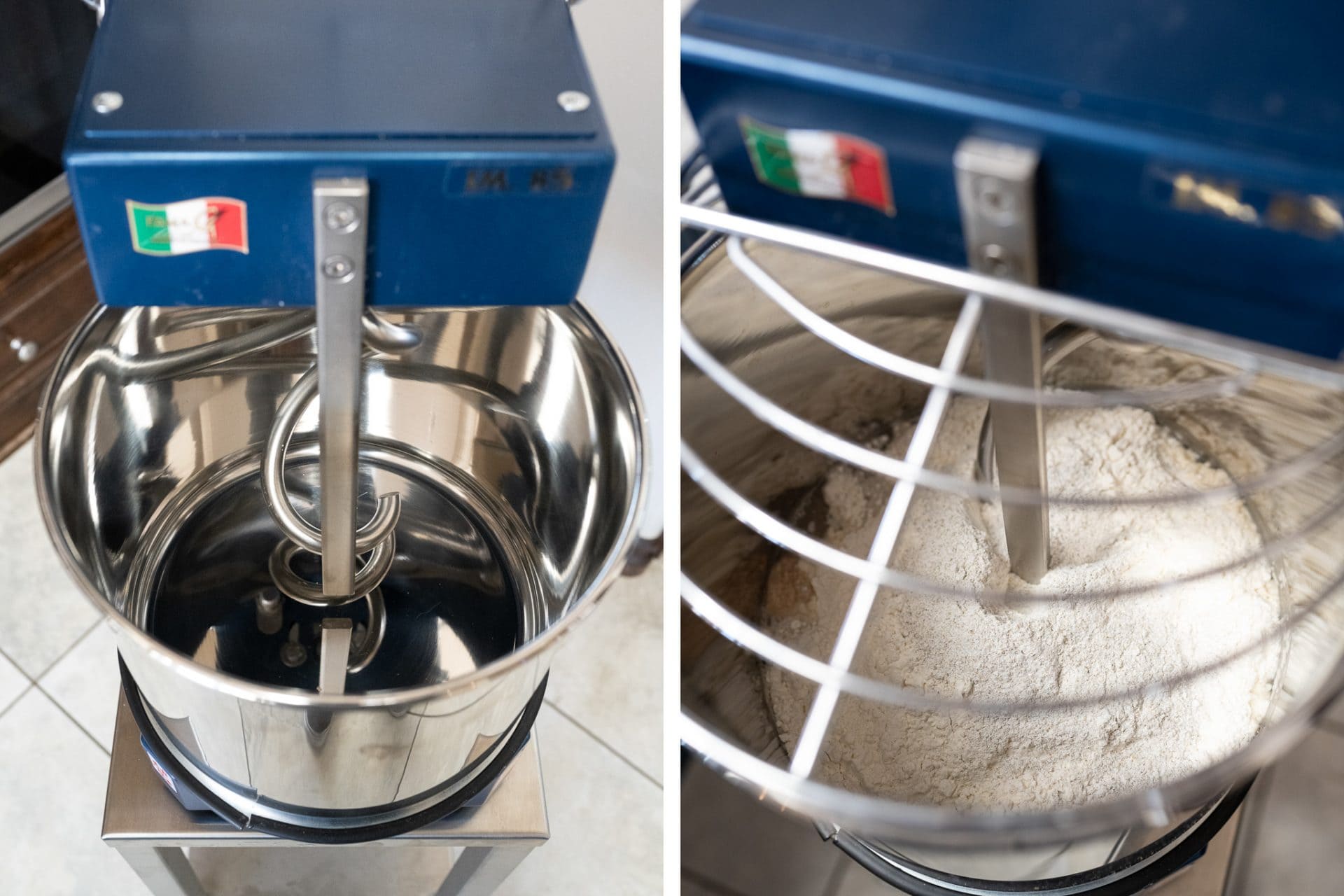
Before we talk about how to use a Famag dough mixer, let’s look at what a breaker bar is and why it’s helpful.
What is a Breaker Bar, and Why is it Useful When Mixing Bread Dough?
A breaker bar is a straight piece of metal that extends down into a mixer’s mixing bowl. The bar is either attached to the mixer’s top and extends down, or sometimes it’s a part of the mixing bowl itself and extends up. In the case of the Famag, it’s attached to the tilting mixer head, raising and lowering as the head is unlocked or locked into place, respectively.
When the tilting head is locked, the breaker bar is positioned very close to the rotating spiral dough hook and scrapes dough off the hook as it spins during mixing. Think of it as someone holding a spatula against the dough hook as it spins: the dough scrapes off the hook with each revolution.
A breaker bar with a spiral dough mixer prevents the dough from climbing up the dough hook, which will eventually require you to stop the mixer and scrape the dough back into the mixing bowl. With the Famag, you turn it on, and it’s mostly hands-off until your dough is done mixing.
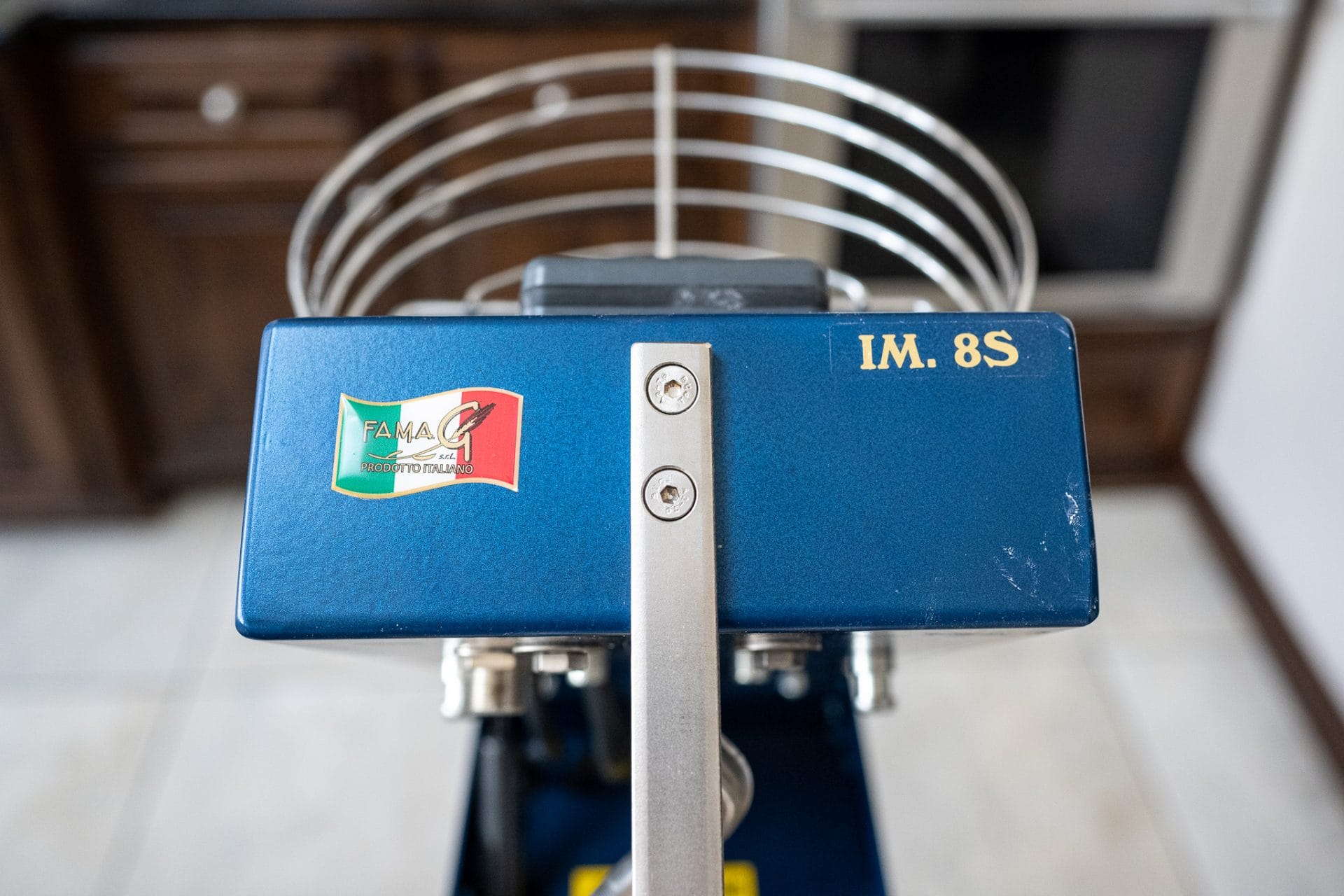
As you can see above, the Famag has the breaker bar attached with two large screws to the front of the tilting mixer head. When the mixing bowl is in place, and the head is lowered, the bar is mostly centered within the mixing bowl.
I was initially worried about how this breaker bar was attached to the mixer’s tilt head: was it strong enough to handle stiff dough? I haven’t seen this ever show signs the bar would pop off, bend, or warp in testing. It flexes slightly, especially when mixing something like my sourdough pretzel dough, but it holds strong and mixes without trouble.
How to Use a Famag Dough Mixer
Using the mixer is incredibly straightforward. I unscrew one of the screw levers that secure the tilt head and hinge it upward. Then, I remove the mixing bowl by turning the bottom locking plate and place the bowl on my kitchen scale. Surprisingly, the tall 8kg capacity Famag mixing bowl fits (barely) on my favorite baking scale, the My Weigh KD8000 scale, which is handy.
Next, I add water to the mixing bowl first (more on this below) to prevent excessive flour from sticking, then add the flour and other ingredients.
As I often do, I hold back about 5-10% of the mixing water at this time. I’ll then add this water in after the dough is strengthened to some degree (commonly called bassinage); this helps develop the gluten in the dough at a faster rate, but also the reserved water can be used to help remove flour from the edges of the mixing bowl by pouring the water slowly right at that corner when the mixer is running.
Then, I transfer the mixing bowl back to the locking plate, turn to lock, drop the wire safety guard, set the dial to #1 (speed 1 in my mapping), tap the black “go” button, and mix until everything is incorporated. I will periodically scrape down the mixing bowl’s sides and the edge during mixing to remove any dry flour.
Let’s look at a few of these steps in detail.
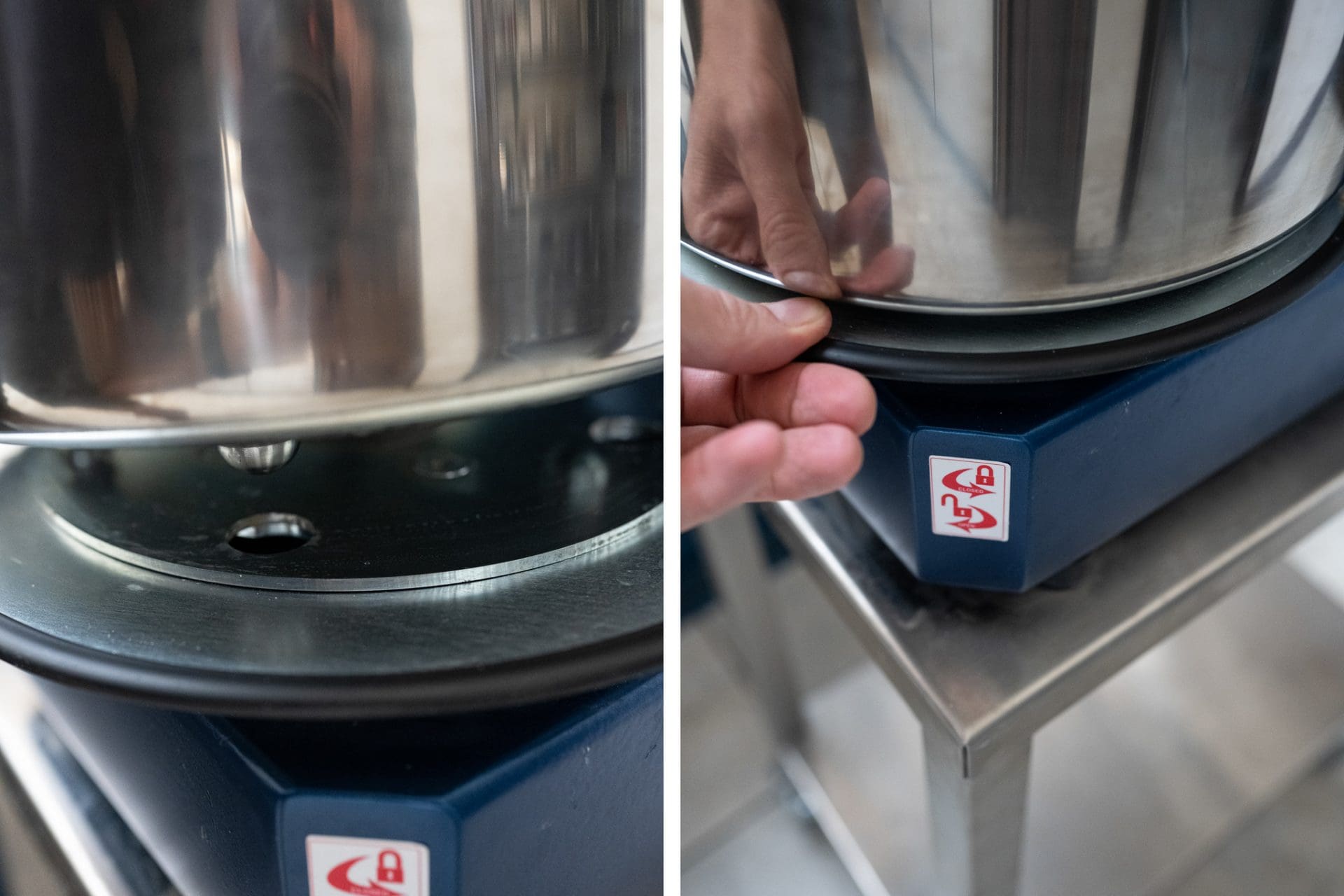
Locking and Unlocking the Removable Mixing Bowl
As you can see above, the mixing bowl fits onto the locking plate by inserting all four metal nubs into holes cut out into the plate. Then, as shown on the white and red sticker, you turn the plate to lock or unlock the mixing bowl. This process is easy, and the bowl locks in securely.
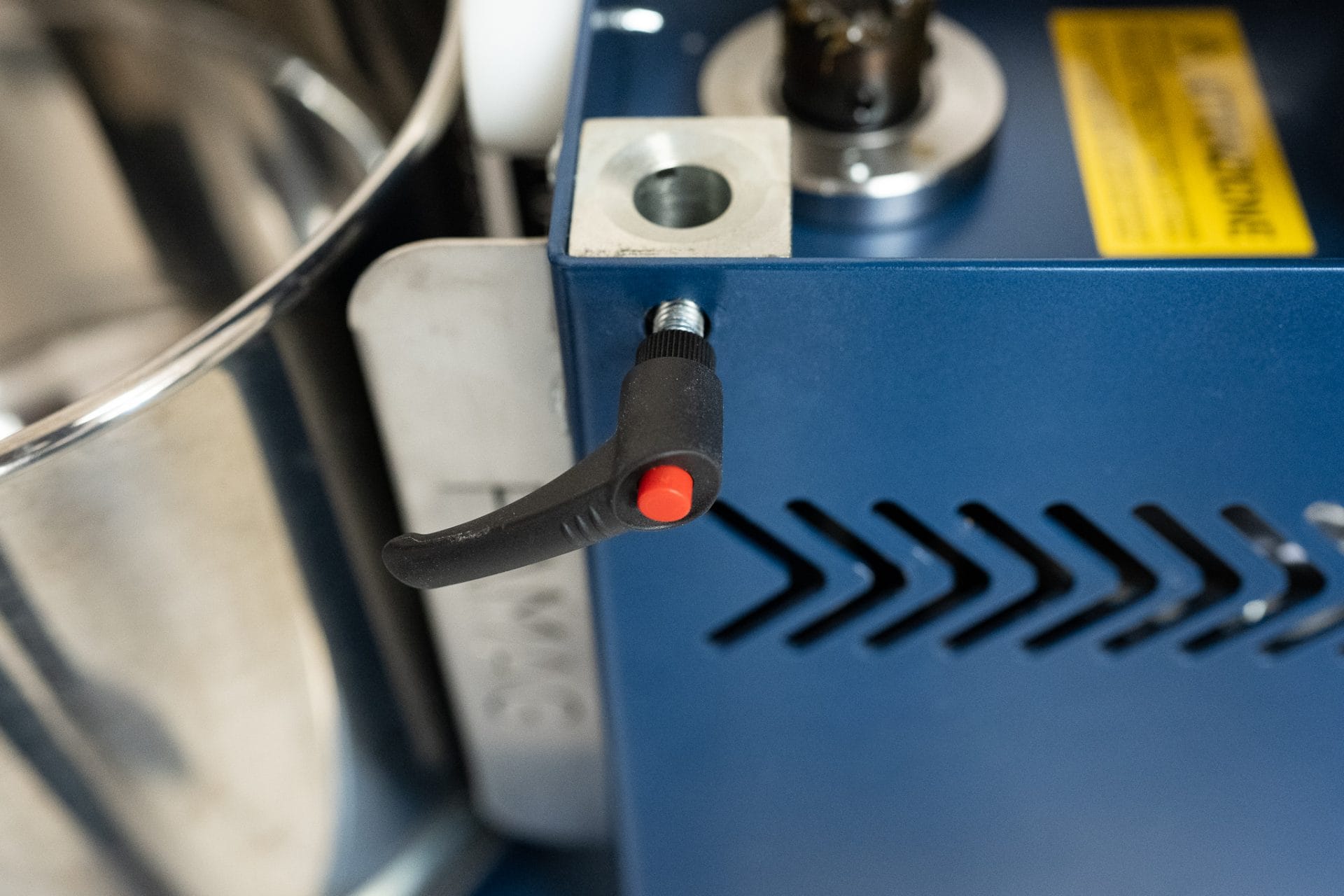
Locking and Unlocking the Tilting Mixer Head
Note: Some older Famag mixers may have a wing nut instead of the straight lever you see above. Mine had the wing nuts, but Pleasant Hill Grain sent me a set of straight levers that come with newer Famag mixers.
As you can see above, the Famag tilting head locks into place with a set of screw levers, one on the right and one on the mixer’s left. These levers unlock the tilting mixer head by screwing it in and out. The on-button will function when the mixer head is down, and the screw is sufficiently screwed in.
While turning the straight screw lever is very easy, I wish the Famag would have used a sliding lock (similar to the Haussler dough mixers) or some other more convenient mechanism. I’ve turned the left screw lever in just far enough to satisfy the safety mechanism but still allow the mixer head to move up or down freely. This way, I must operate the right side lever to lock or unlock the tilting mixer head.
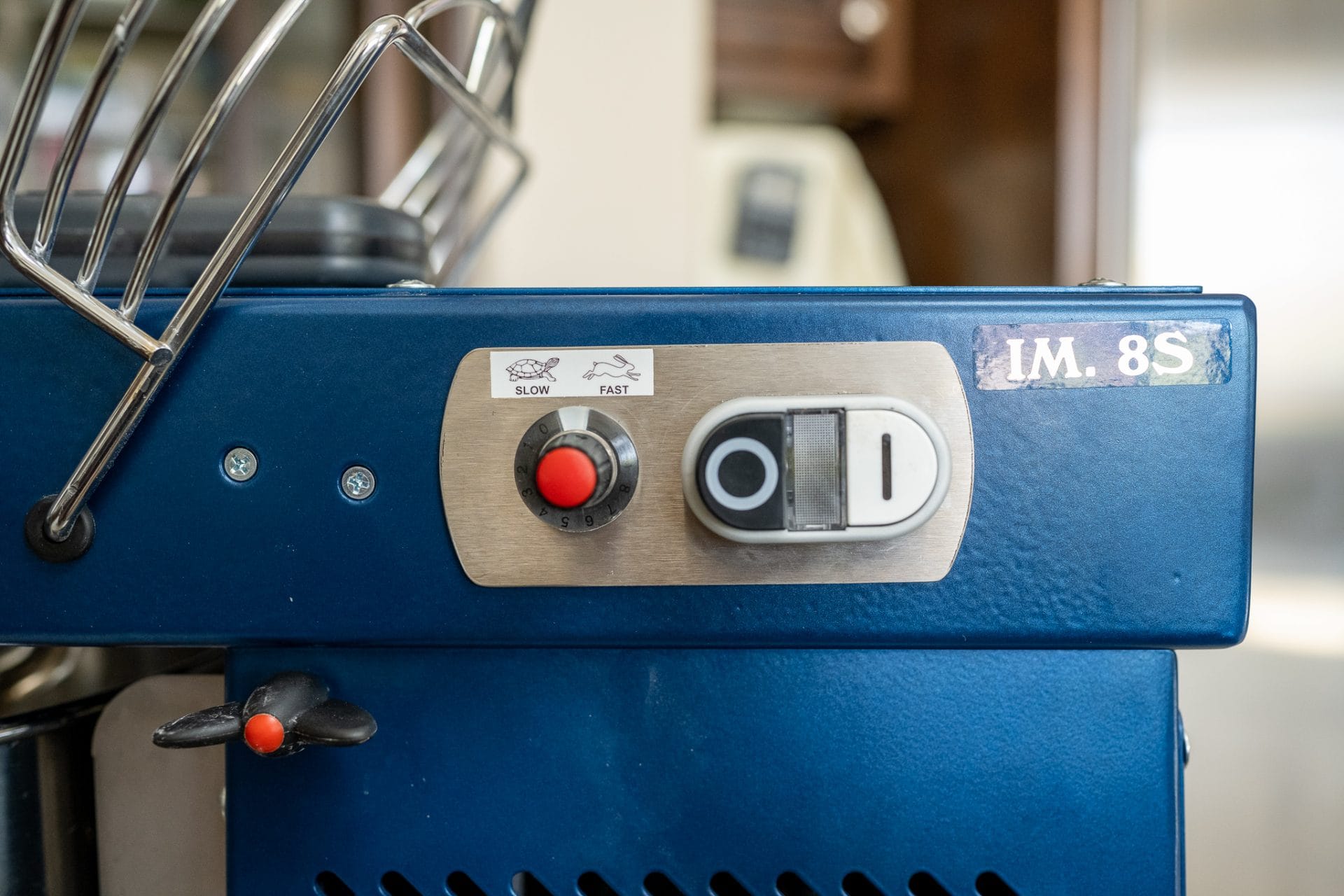
Controlling the Mixing Speed
The Famag dough mixer has a variable dial (as seen above under the turtle and rabbit sticker) for controlling the spiral dough hook’s revolutions per minute (RPM) and the mixing bowl’s rotation. The RPMs range from slowest at speed #0 to fastest at speed #10:
| Speed | Hook RPM | Bowl RPM |
|---|---|---|
| Slowest speed (#0 on the speed dial) | 80 | 8 |
| Fastest speed (#10 on the speed dial) | 240 | 24 |
I think the variable speed dial on the Famag mixer is unnecessary. Other spiral dough mixers I’ve used typically only have a speed one and speed two, which is wholly sufficient. On these other mixers, speed one is for ingredient incorporation or gentle mixing, and speed two is for rapid gluten development.
Variable Speed Update: After using this mixer for more time, I’ve actually found the variable speed dial very useful when making other products besides bread. For example, when making panettone, it’s useful to be able to mix at very slow speeds to avoid overheating the dough, even at speed 0.
On the Famag dial, I use #2 as a typical speed one and #6 as a typical speed two.
In my testing, I’ve mapped the Famag variable speed dial to what I would typically use, speeds one and two. I use speed #2 on the variable dial to equal my typical speed one, and speed #6 as my typical speed two.
My Typical Mixing Times
No mixing times are universally applicable to every type of bread dough. Depending on your process, higher hydration doughs typically require longer mixing times. Conversely, lower hydration doughs might not require as much.
For my typical loaves of sourdough bread, such as with my spelt, rye, and whole wheat sourdough bread, I might typically do the following mix schedule. The following assumes the dough did not have an autolyse, which might reduce the overall mixing time required).
- 2 to 3 minutes on first speed (which is #1 on the Famag speed dial)
- Optional rest (5-10 minutes)
- 1 to 3 minutes on second speed (which is #6 on the Famag speed dial)
The first phase of mixing is mostly incorporating the ingredients and ensuring everything is homogenous. The rest helps the dough come together and firm up some, and is not always necessary.
The second phase of mixing is when the gluten in the dough is substantially developed, typically between one and three minutes for most of my doughs. Still, it might be longer if the dough is highly hydrated or needs additional time to develop more elasticity.
Recommended reading: How to Autolyse Bread Dough to help reduce mixing time.
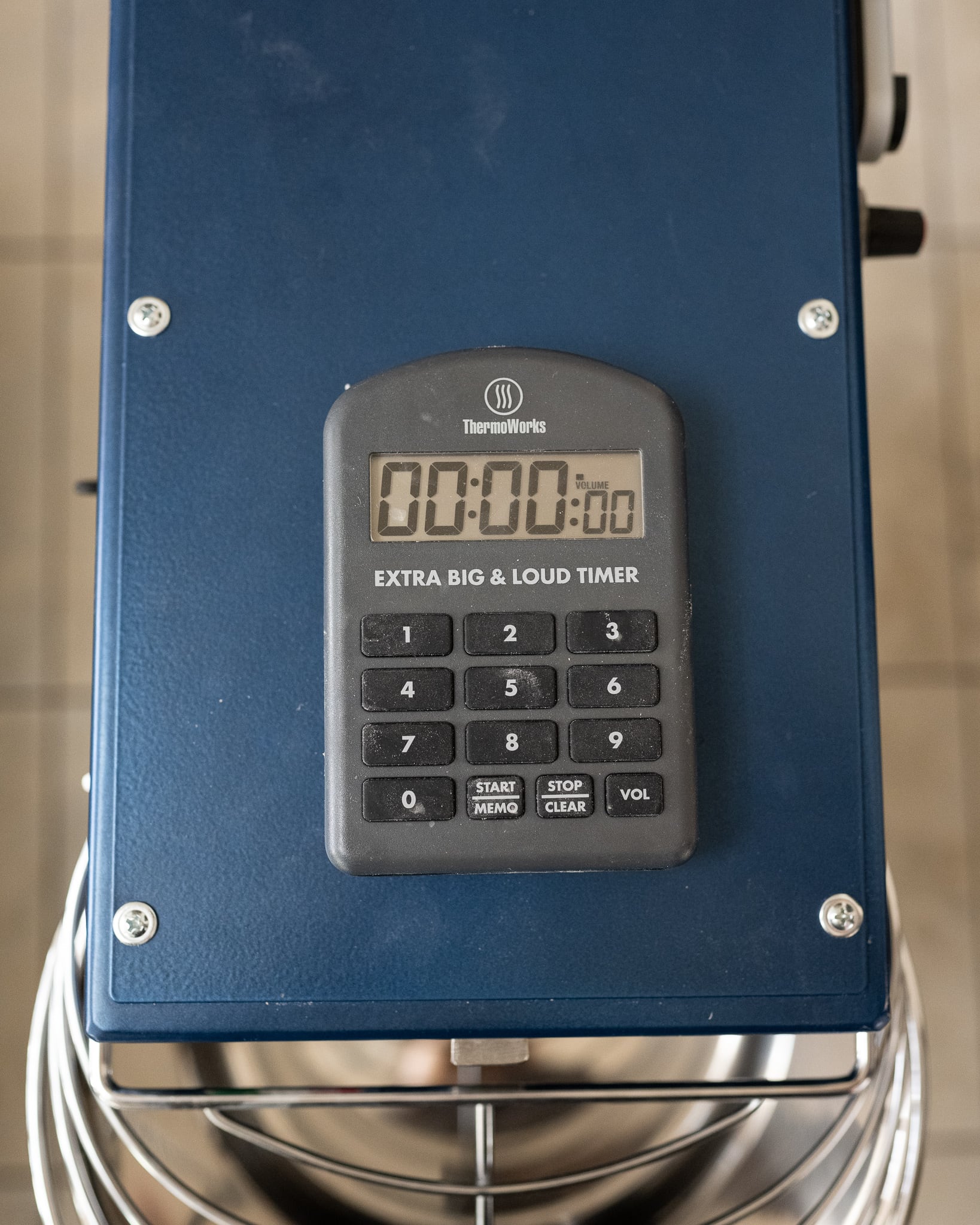
I like to keep a magnetic timer attached to the top of the Famag spiral dough mixer. When I push on the button to start mixing, I start the timer. This helps me keep track of mixing times, and I can mostly walk away and do other baking tasks.
Maximum and Minimum Mixing Dough Weight
| Dough weight | Notes |
|---|---|
| Minimum | The Famag can handle smaller batches of dough, but I’ve found anything below 1,800g of dough too small for the mixer to mix effectively. It’s possible to go lower, but when dipping below 1,800g, I’ll typically mix the dough by hand. |
| Maximum | I’ve mixed up to 8,000g in the Famag without a problem. I haven’t tested outside this range, but I’ll update this post if I get there! |
Mixing Pizza Dough with the Famag Dough Mixer
The Famag spiral dough mixer handles pizza dough incredibly well. I use the Famag to make my sourdough pizza dough recipe in larger quantities. I don’t mix my pizza dough excessively; usually, I mix for only 1 to 2 minutes on the first speed and then 1 to 3 minutes on the second speed.
Cleaning
I find it best to clean the mixing bowl, breaker bar, and dough hook immediately after mixing. It becomes tough to scrape off if the dough is left to dry and cake on the bowl or any other surface.
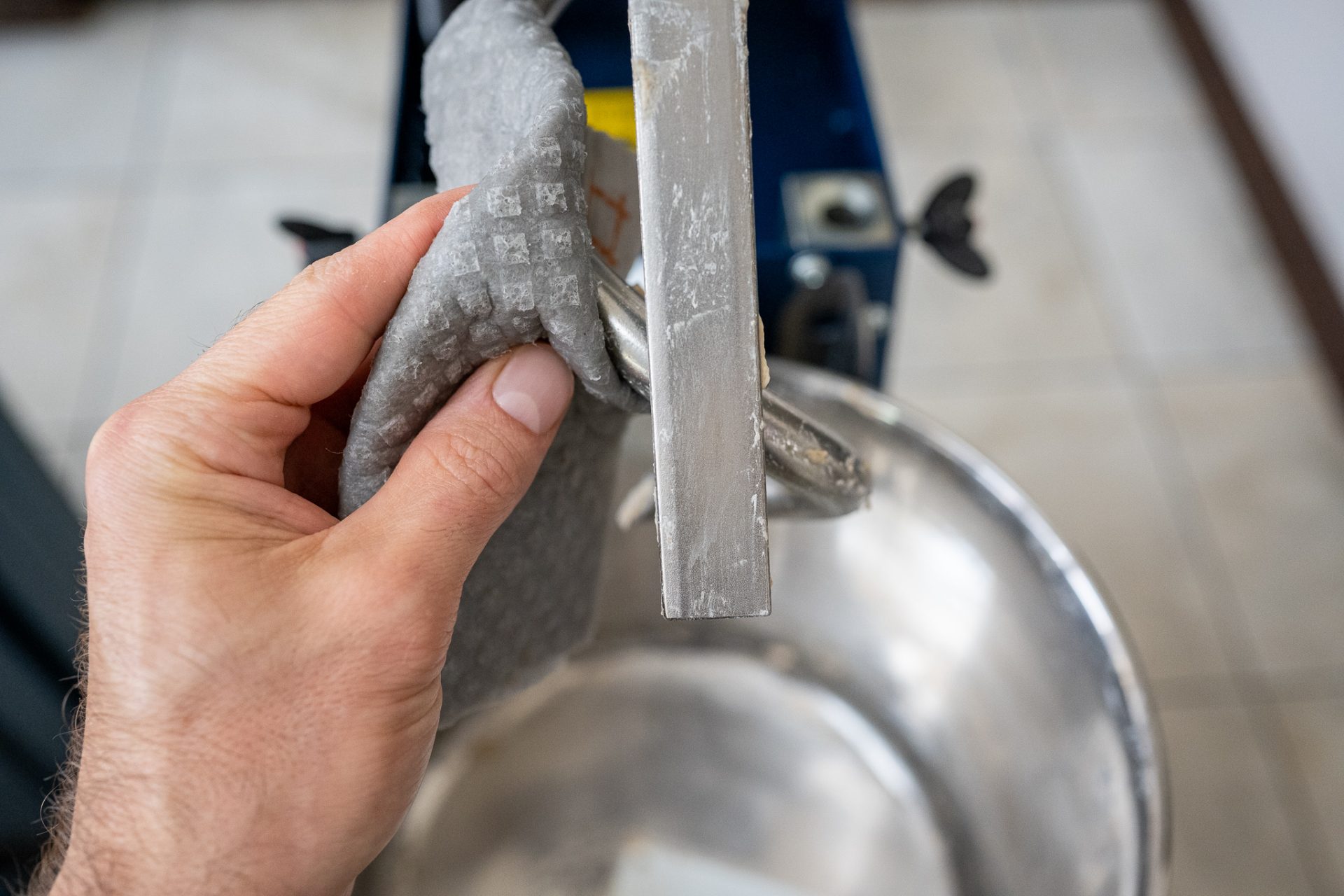
When I finish mixing my dough, I scrape the dough out of the mixing bowl into my bulk fermentation container. Then, I place the mixing bowl back into the mixer base and clean the dough hook and breaker bar with a damp sponge cloth (I like these reusable cloths, they’re compostable and grippy enough to pull the dough off the mixer). The mixer bowl in place catches any water falling while wiping. Then, I transfer the bowl to the sink to continue to wash any dough bits off using the damp cloth.
Flour Sticking to Mixing Bowl
Many bakers say flour sticks to the bottom of the mixing bowl when using a spiral dough mixer. I’ve found a few tricks to help with this issue after many, many mixes in the Famag dough mixer.
First, add water to the mixing bowl before the flour or other ingredients. Also, as I described above, hold back 5 to 10% of the mixing water. This held-back water will not only help you adjust for the dough’s consistency that day in the kitchen3, but you can stream in the water during mixing right to the edge of the mixing bowl to help release some of that stuck flour.
I find this “double hydration” also helps because it allows you to first quickly strengthen the dough (even if you’re using a high percentage of high-protein white flour), then add more water without overloading the dough, causing it to spread.
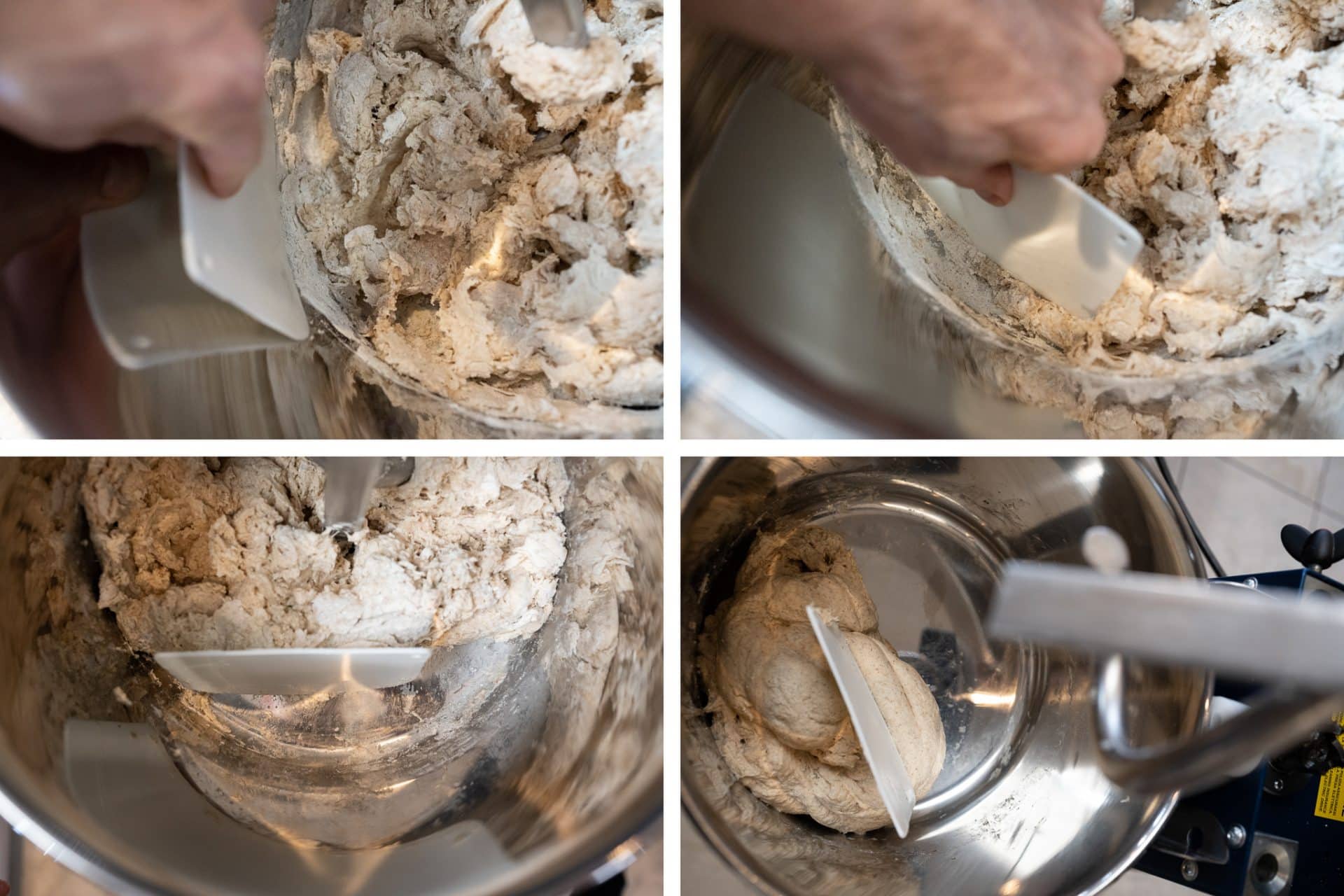
As you can see above, using a plastic bowl scraper to periodically scrape the mixing bowl’s sides will help remove any stuck flour. I like to use these plastic Ateco scrapers because they can gently bend to match the mixing bowl’s curvature, making for a clean scrape.
Famag Spiral Dough Mixer Maintenance
Aside from keeping the mixer clean during normal use, the one spot I know I’ll have to pay attention to is where the mixing head connects to the unit’s base. As you can see below, a lubricant keeps the joint between the motor shaft and the top gear assembly. Mine has plenty of lubricants, but I plan to use a food-grade lubricant on this joint as necessary. This is a typical maintenance task for any mixer.
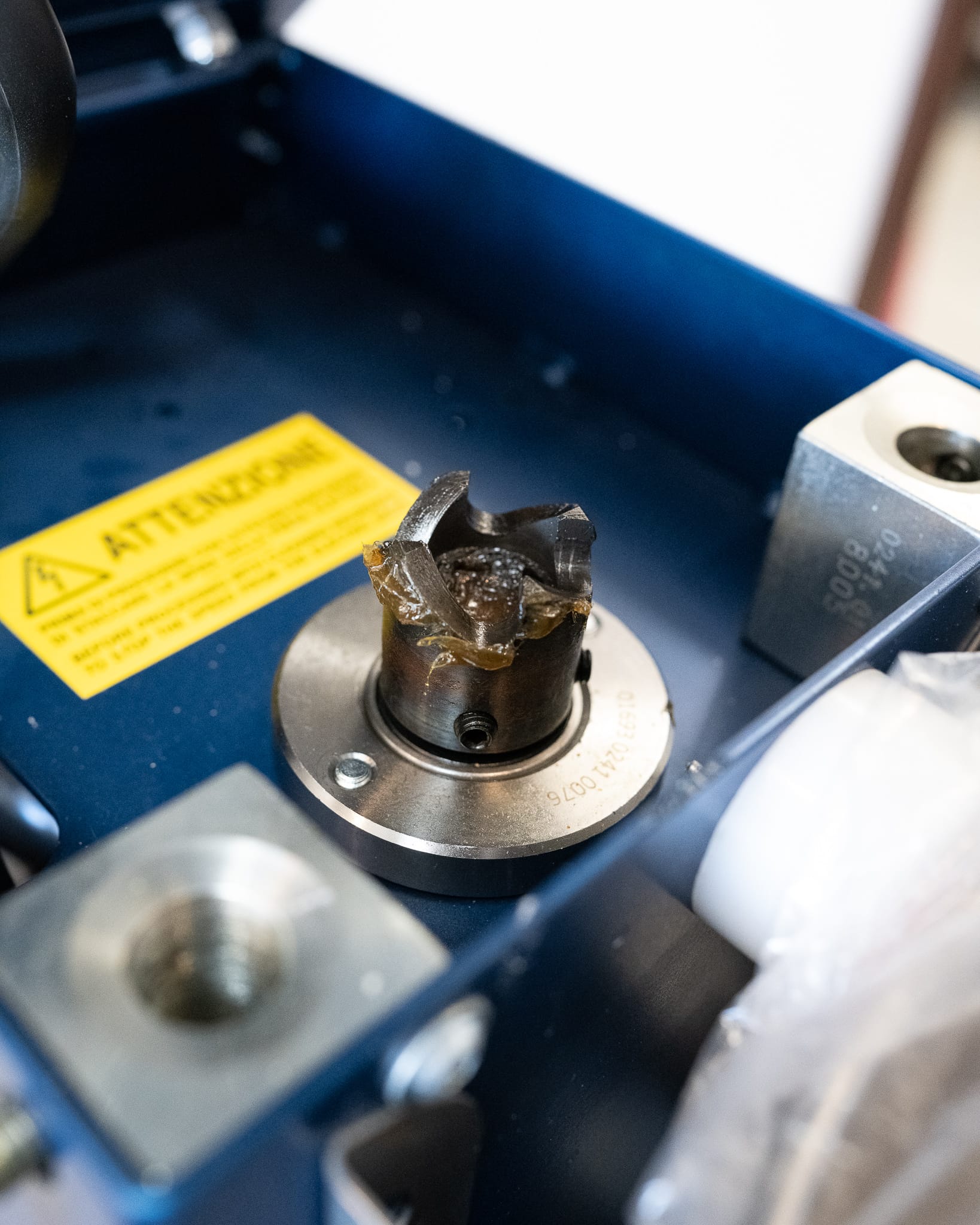
Moving the Mixer
The Famag dough mixer is a heavy piece of machinery. While it is possible to pick it up and move it around your kitchen (and I do this periodically), I prefer to keep it on a metal cart with castors for rolling around.
The cart pictured is the Haussler steel cart, which fits this Famag and the Haussler Alpha mixer. There’s another cart available that perfectly fits the Famag (and is the one I’d get if buying the mixer today).
Famag Wish List
I couldn’t write a how-to-use a Famag dough mixer guide without listing a few things I wish the mixer would change or have. Here’s my short list of minor issues and things I wish the mixer had:
- Mixing reverse: some of the Famag spiral mixers have a reverse function, but my version does not. A reverse sets the bowl and hook moving in the opposite direction than when mixing. This makes cleanup easier as any dough stuck to the hook will slide off when running in reverse.
- Only two speeds, speed 1 and speed 2: having an analog speed control with ten speeds isn’t necessary; in the end, I use the same positions on the dial (speed 1 and speed 5) to approximate a typical mixer with speed 1 and speed 2 (low and high).
- A better mixer head locking mechanism: spinning the lever to tighten the tilting head is incredibly easy, but I’d much prefer a sliding head locking mechanism like the Haussler Alpha (a large steel bar slides into the base to lock the head).
- Mixing timer control: it would be nice if you could set a timer for the mixing duration.
Even with those wants, I still think it’s one of the best home mixers you can buy, especially with a breaker bar.
Conclusion
In the end, I think this Famag IM 8S spiral dough mixer is one of the best mixers for the home kitchen (and some commercial kitchens, especially the larger capacity versions). The mixer has a breaker bar, which is a rarity in smaller spiral mixers, making it much more desirable. Also, the mixer is thoughtfully designed and solidly built. There are a few things I wish were changed and a few things I wish they had, but I think that’s always the case with any piece of equipment.
In the end, I’d recommend the Famag for any sourdough bread baker looking to mix larger batches of bread dough from the home kitchen.
What’s Next?
Have any questions about how to use a Famag dough mixer or spiral dough mixers in general? Feel free to drop a comment below, and I’ll see if I can help!
If you’re looking for more professional-level bread-baking equipment, check out my writeup on the Rofco B40 bread oven or the larger RackMaster RM2020 Bread Oven, both workhorses for any home or professional baker.
Check out a few of my most-baked bread recipes that will benefit from using a larger commercial spiral dough mixer:
High-fiber seeded sourdough bread recipe
Spelt, Rye, and Whole Wheat Sourdough Bread
A Simple Sourdough Focaccia
How to Use a Famag Dough Mixer FAQ
How long do I knead dough in my dough mixer?
It ultimately depends on the bread dough formula itself. But generally, I mix for 2 to 3 minutes on speed 1, and then 3 to 4 minutes on speed 2.
How do I keep flour from sticking to the bottom of the mixer bowl?
I like to add water to the mixing bowl first, then the flour and other ingredients. In addition, I use a plastic scraper to scrape the sides of the dough while mixing to prevent dry flour accumulation. Finally, add a little water while the mixer runs to help loosen the dried flour.
What is a breaker bar on a spiral dough mixer?
A breaker bar is a bar in the middle of the mixing bowl that helps keep the dough from climbing or riding up the dough hook during mixing.


